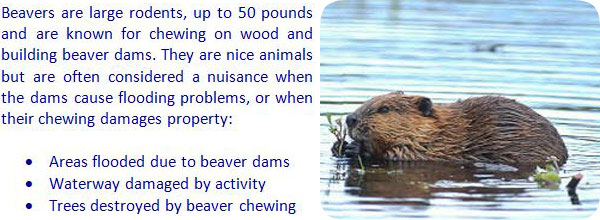- info@wildlifeanimalcontrol.com
Call us for help in your town
Wildlife Control Education
How to Catch a Beaver in a Live Trap or Pond?

Need beaver removal in your hometown? We service over 500 USA locations! Click here to hire us in your town and check prices - updated for year 2020.
Believe it or not, Beavers are the second largest rodents in the world. Largely nocturnal, these large, flat-tailed creatures build and live in dams. Using their impressive large front teeth they can cut down trees to build their large, water bound homes.
Beavers used to be hunted for their pelts and as a result, they neared extinction in the late eighties. The sharp decline was as a result of the beavers being killed and used to make furs, perfume and medicine. Beavers are now primarily found in North America and parts of Europe.
While they reside mostly in their dams, which they build in streams, these web-footed herbivores will often make their way into a stream or smaller body of water close to a residential neighborhood. Beavers can wreak havoc on the landscape design of a backyard in their quest for the woods of cherry, cottonwood and willow trees as well as water lilies.
If you have noticed an abundance of missing trees and shrubs in your backyard, take a look around for small bodies of water for telltale signs that a beaver may be living nearby. Their dams are amazingly well built, with sections of it being intertwined in a crisscross type pattern. These homes are partially submerged, with the entrance being underwater. Keep an eye out for what looks to be a bunch of branches forming a little hill in the water near your house.
When you suspect that a beaver has made itself your new neighbor, it might be best to remove the rodent from your premises to avoid any further damage to your landscaping and tree cover. Removing a beaver can be difficult, but it is a definite possibility with a little help and a little know-how. Below are a few methods used to catch beavers. It is important to note that beavers are critical to the ecosystem in which they live and in some parts of the world, it is against the law to harm or kill them. Therefore, the safest and most humane ways to catch a beaver are generally the most strongly suggested.
Learn all About Beavers
Prevention
One of the easiest ways to catch a beaver is to make sure that you never have one! If you have a largely treed area you can fence them out to ensure that they do not get near any of the trees and obviously, cannot cut them down. This solution is best used on a smaller area, as it can get expensive if you are using galvanized fencing for a larger yard. If fencing is not an option, you can find beaver repellants in larger home improvement and hardware stores. Sprayed directly onto at risk trees and plants, the repellant should deter beavers from making a meal of your shrubs.
Find out more: How to stop beavers eating trees?
Dam Destruction
The best way to catch a beaver is to remove its home from your backyard. Beavers are known to be able to take down large trees up to 10 inches in diameter in a single night. They are quick builders who maintain their primary dams impeccably and can rebuild a destroyed dam literally overnight. While commendable, this makes a dam very difficult to remove without actually catching and relocating the beaver. Monitor the movements of the beaver(s) for a few days and when you are confident that the beaver has left, you can begin to dismantle the dam. Enlist the help of a friend, relative or neighbor to make sure that all of the parts of the dam are removed so that there are no remnants left to rebuild with. The best way to do this is with a wood chipper, but if one is not available to you then bind the sticks with twine and move them to a garage or patio where the beaver will have no access to them. Once the beaver returns, use the live trapping method below to catch the beaver and relocate it so that it does not rebuild on your lot.
Live Trap
A spring-loaded trap also known as a body grip is the most effective way to catch a beaver. Set in the body of water or on land, the device snaps shut when a beaver walks or swims into it. Always make sure that the animal is subdued, or use a snare pole to hold the animal when releasing it from the trap. You run the risk of getting bitten or scratched when trying to approach an aggressive beaver, so ensure that you are taking the proper precautions and recruit a friend to help.
More in-detail how-to beaver removal articles:
Information about beaver trapping - analysis and methods
for how to trap.
Information about how to kill a beaver - with poison or other methods.
Information about how to keep beavers away - prevention techniques.
Information about beaver repellent - analysis of types and effectiveness.
This site is intended to provide information about how to catch a beaver education and information, so that you can make an informed decision
if you need to deal with a beaver problem. This site provides many beaver capture articles and strategies, if
you wish to attempt to solve the problem yourself. If you are unable to do so, which is likely with many
cases of beaver removal, please go to the home page and click the USA map, where I have wildlife removal experts
listed in over 500 cites and towns, who can properly help you with your nuisance beaver.
Click here to
read more about how to get rid of beavers.

















